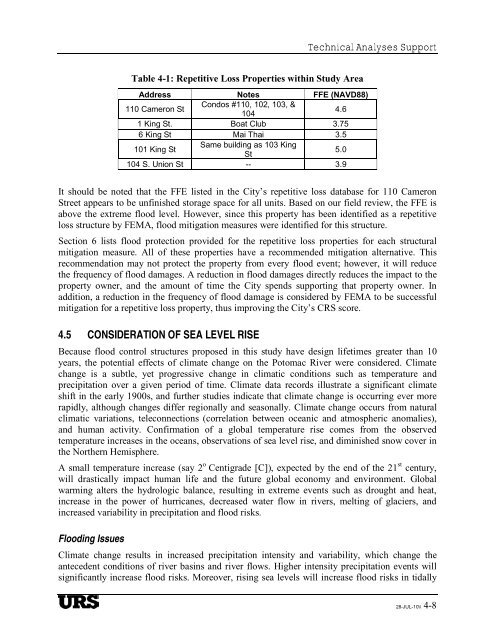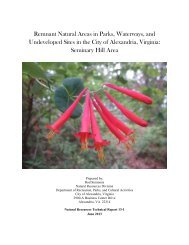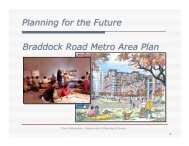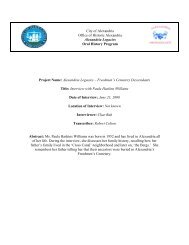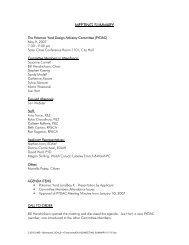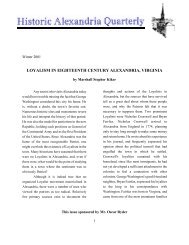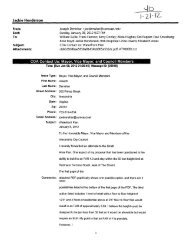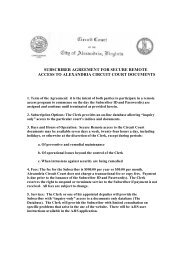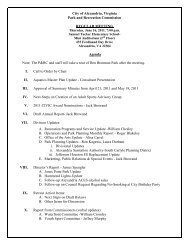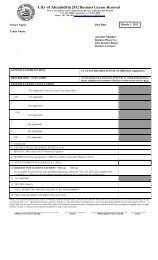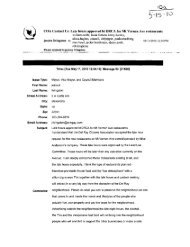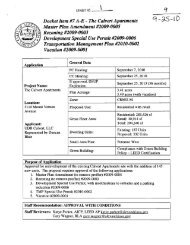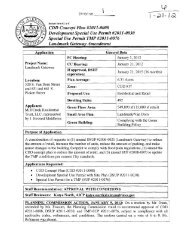Potomac Waterfront Flood Mitigation Study - City of Alexandria
Potomac Waterfront Flood Mitigation Study - City of Alexandria
Potomac Waterfront Flood Mitigation Study - City of Alexandria
You also want an ePaper? Increase the reach of your titles
YUMPU automatically turns print PDFs into web optimized ePapers that Google loves.
Table 4-1: Repetitive Loss Properties within <strong>Study</strong> Area<br />
Address Notes FFE (NAVD88)<br />
110 Cameron St<br />
Condos #110, 102, 103, &<br />
104<br />
4.6<br />
1 King St. Boat Club 3.75<br />
6 King St Mai Thai 3.5<br />
101 King St<br />
Same building as 103 King<br />
St<br />
5.0<br />
104 S. Union St -- 3.9<br />
Technical Analyses Support<br />
It should be noted that the FFE listed in the <strong>City</strong>’s repetitive loss database for 110 Cameron<br />
Street appears to be unfinished storage space for all units. Based on our field review, the FFE is<br />
above the extreme flood level. However, since this property has been identified as a repetitive<br />
loss structure by FEMA, flood mitigation measures were identified for this structure.<br />
Section 6 lists flood protection provided for the repetitive loss properties for each structural<br />
mitigation measure. All <strong>of</strong> these properties have a recommended mitigation alternative. This<br />
recommendation may not protect the property from every flood event; however, it will reduce<br />
the frequency <strong>of</strong> flood damages. A reduction in flood damages directly reduces the impact to the<br />
property owner, and the amount <strong>of</strong> time the <strong>City</strong> spends supporting that property owner. In<br />
addition, a reduction in the frequency <strong>of</strong> flood damage is considered by FEMA to be successful<br />
mitigation for a repetitive loss property, thus improving the <strong>City</strong>’s CRS score.<br />
4.5 CONSIDERATION OF SEA LEVEL RISE<br />
Because flood control structures proposed in this study have design lifetimes greater than 10<br />
years, the potential effects <strong>of</strong> climate change on the <strong>Potomac</strong> River were considered. Climate<br />
change is a subtle, yet progressive change in climatic conditions such as temperature and<br />
precipitation over a given period <strong>of</strong> time. Climate data records illustrate a significant climate<br />
shift in the early 1900s, and further studies indicate that climate change is occurring ever more<br />
rapidly, although changes differ regionally and seasonally. Climate change occurs from natural<br />
climatic variations, teleconnections (correlation between oceanic and atmospheric anomalies),<br />
and human activity. Confirmation <strong>of</strong> a global temperature rise comes from the observed<br />
temperature increases in the oceans, observations <strong>of</strong> sea level rise, and diminished snow cover in<br />
the Northern Hemisphere.<br />
A small temperature increase (say 2 o Centigrade [C]), expected by the end <strong>of</strong> the 21 st century,<br />
will drastically impact human life and the future global economy and environment. Global<br />
warming alters the hydrologic balance, resulting in extreme events such as drought and heat,<br />
increase in the power <strong>of</strong> hurricanes, decreased water flow in rivers, melting <strong>of</strong> glaciers, and<br />
increased variability in precipitation and flood risks.<br />
<strong>Flood</strong>ing Issues<br />
Climate change results in increased precipitation intensity and variability, which change the<br />
antecedent conditions <strong>of</strong> river basins and river flows. Higher intensity precipitation events will<br />
significantly increase flood risks. Moreover, rising sea levels will increase flood risks in tidally<br />
28-JUL-10\\ 4-8


